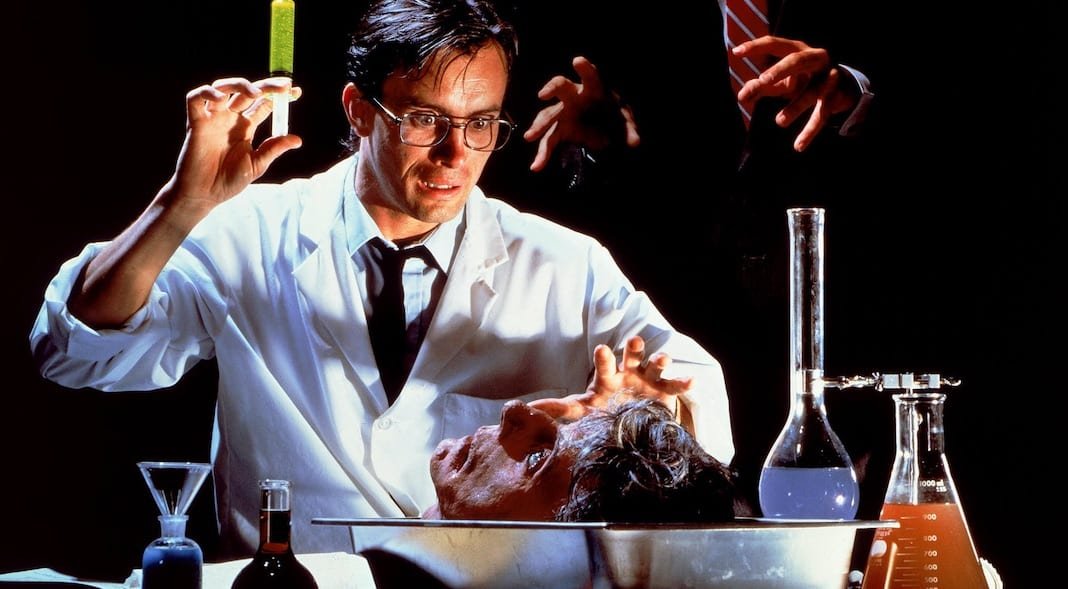Plagiarism in Pop Culture: Re-Animator
It's October, so let's talk about some Halloween-appropriate films...
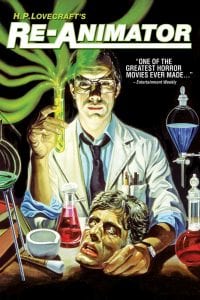
Re-Animator (sometimes spelled Reanimator) is a 1985 horror film best known its story by H.P. Lovecraft, over-the-top gore, practical effects and zany acting.
Much like the Evil Dead series, it’s a film that treads the line between comedy and horror, giving ample doses of both and never really settling into one genre.
Because of that, the film, as well as the sequels it spawned, are heralded as cult classic films that continue to be the subject of midnight screenings and horror film festivals more than thirty years after its release.
However, one thing that doesn’t get a great deal of discussion is how central plagiarism is to the plot of the film. It might be strange to think of a blood-soaked and zombie-filled film as having its plot driven by a relatively pedestrian plagiarism plot, but it absolutely does.
To understand how and why we have to first take a look at the plot of the Re-Animator films and then examine the plagiarism itself to understand just how likely, or even common, it really is.
Content Warning: Spoilers for Both Re-Animator and Bride of Re-Animator Below. Descriptions may include horror and violent themes.
The Plot

Note: Since we are not covering just a single TV episode, this recap will be both a bit longer and less complete than normal for this series.
The film opens at the Zurich University Institute of Medicine as police and university staff are responding to screams in one of the offices. After breaking in, they discover medical student Herbert West kneeling over his professor, Dr. Hans Gruber, who is on the floor screaming in anguish.
The police pull West off and Dr. Gruber springs up, only to die a gory death as West attempts to explain that the dosage was “too high”. One of the other professors accuses West of killing Dr. Gruber to which he responds, “I gave him life!”
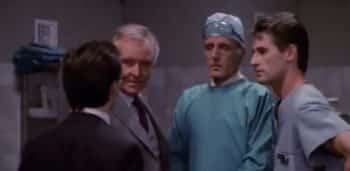
The film then cuts to the Miskatonic Medical School in Arkham, Massachusetts. There, another medical student, Dan Cain fails to revive a woman and has to take her to the morgue. He then runs into Dr. Alan Halsey, dean of the school. Dr. Halsey introduces Cain to West saying he will be joining him for his third year after performing “independent study” in Switzerland.
Dr. Halsey also introduces West to Dr. Carl Hill, dubbing him their “imminent brain researcher and grant machine.” However, West is unimpressed, saying, with some anger, that he knows Dr. Hill’s work.
“Your theory on the location of the will in the brain is… interesting… though derivative of Dr. Gruber’s research in the early 70s. So derivative in fact that, in Europe, it’s considered plagiarized…”
West then continues to call Dr. Hill’s work on brain death “outdated”. The tense standoff ends with Dr. Hill saying he’s looking forward to seeing West in class.
We then learn that Cain is dating Megan, Dr. Halsey’s daughter, though Dr. Halsey doesn’t completely approve. It’s then that West shows up to rent a room from Cain, which Cain agrees to over Megan’s objections.
The room in question is Cain’s basement, which west gets to work setting up as a laboratory.
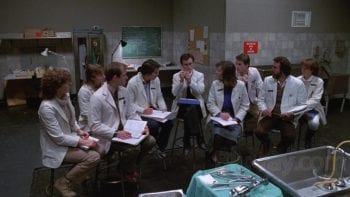
Later, in class, West confronts Dr. Hill again after he attempts to explain the location of the will in the brain. West says, “You know, you should have stolen more of Gruber’s ideas, then at least you’d have ideas!” Hill responds by saying it was going to be a pleasure to fail him.
Back at the house, Cain discovers his dead cat in West’s refrigerator, but West explains the cat died in an accident. That night, West attempts to reanimate the cat, but it becomes violent and attacks him, forcing Cain and West to work together to kill it again.
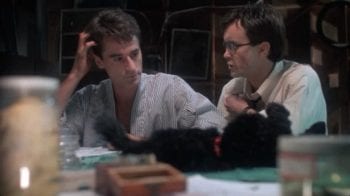
This forces West to confide in Cain about the secret of his re-agent. However, by this time Dr. Hill has turned Dr. Halsey against West and Cain, so, when Cain tried to tell Dr. Halsey about the re-agent, Dr. Halsey kicks both of them out of school for conducting unauthorized experiments.
In a bid to save their careers, the duo sneak into the morgue and attempt to re-animate a corpse. They successfully do so but the corpse becomes violent and attacks Dr. Halsey, who walks in at an inopportune moment, killing him. However, Cain and West re-animate Dr. Halsey, prompting him too to go mad. In the end, Dr. Halsey is locked in a padded room, under Dr. Hill’s care.
Dr. Hill then confronts West, saying that he knows Halsey should be dead. Dr. Hill says that he wants West’s discovery and threatens to have him locked up if he doesn’t give the discovery to him. West initially plays along but strikes Dr. Hill from behind and kills him, calling him a “plagiarists” as he decapitates him with a shovel.
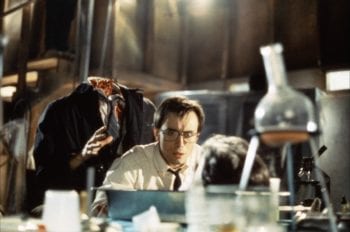
West re-animates the head and body of Dr. Hill separately only to have body grab him from behind and knock him unconscious. When he comes to, all of his work has been stolen. Dr. Hill, who is able to control re-animated corpses telepathically, then frees Dr. Halsey and uses him to kidnap Megan.
Cain and West go to the Morgue to rescue Megan but are attacked by the other re-animated corpses. They eventually convince the re-animated Dr. Halsey to protect his daughter and he crushes the head of Dr. Hill. The three go to make their escape but West is ensnared by the body of Dr. Hill. Megan is attacked by another corpse and eventually killed.
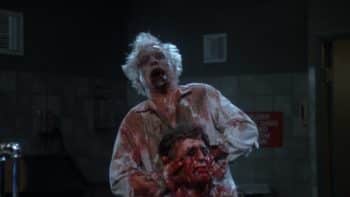
The film ends with Cain injecting Megan with re-agent and cuts to black as she screams.
The story continues in the sequel, Bride of Re-Animator, which ignores the death of West or the destruction of Hill’s head. The plot of the film centers around West trying to build a “bride” for Cain using Megan’s heart while Hill uses his telepathic powers to try and take revenge on West for the events of the first film.
The film ends in the seemingly final death of Hill as he and the other re-animated corpses are killed when a crypt collapses on top of them.
Understanding the Plagiarism
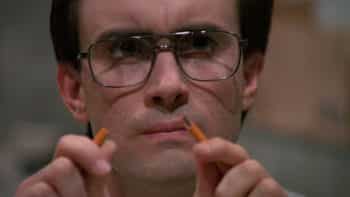
The story actually features two separate plagiarism plot lines, both centering on Dr. Hill.
The first is Dr. Hill’s prior plagiarism. West accuses Dr. Hill, with at least some veracity, of stealing work from Dr. Gruber. It is at least implied that this plagiarism is part of the reason Dr. Hill ended up at Miskatonic, where his work is now heralded as groundbreaking and genius.
In the 1980s, this was certainly possible and likely even common. Before the internet, research often struggled to reach a global audience. Discoveries made in one place might not be learned about in another for years.
It’s entirely possible that a researcher could learn about a discovery in one part of the world and take it to another and present it as their original work. Though there were international journals and conferences for sharing such findings, they didn’t expose research nearly as broadly as we see today.
In short, the idea that Dr. Hill could be a disgraced plagiarist in Europe but be heralded as an original genius in the United States is plausible, especially considering there was also limited sharing of information when it came to plagiarism (Retraction Watch, for example, wouldn’t be founded for another 25 years).
This isn’t to say that Dr. Hill would have gotten away with it forever, but that he likely could have done so for a length of time.
The second plagiarism plot involves Dr. Hill trying to steal West’s work. He wanted the discovery for himself and even went as far as to use his disembodied corpse to knock West out to steal it.
The problem with that is that there was simply no reason to do any of it. As West’s instructor, it would have been much easier to just shoehorn himself as an author on any paper West published (after getting him reinstated).
Disputes like this happen with surprising frequency, even the recent Dartmouth plagiarism controversy featured a professor accused of not properly crediting an associate professor for his work. Likewise, there’s a 2015 story involving a University of Arizona professor who plagiarized a student’s work and was awarded tenure despite being reprimanded for it.
Dr. Hill didn’t need to threaten or bully West to take credit for his discovery. He could have done it much more easily by helping West and taking disproportionate credit later In short, the entire latter part of the movie could have been avoided if Dr. Hill had simply been a smarter plagiarist.
In the end, such academic plagiarism doesn’t usually involve the stealing of notes or the theft of re-agent. Instead, it involves pressure to add authors that don’t belong or remove those who do.
Dr. Hill clearly forgot that and lost his head for it.
Bottom Line
Should a comedy-horror film known for its over-the-top violence and camp humor be required to feature a realistic portrayal of plagiarism? Probably not.
At least no more than it features a realistic portrayal of anatomy, psychology or the legal system.
Re-animator simply isn’t meant to be a realistic movie and anyone hoping to learn anything from the film, let alone about plagiarism, is going to be very disappointed.
Still, given just how central plagiarism is to the plot, it’s interesting that a better plagiarist likely could have avoided the consequences of the latter half of the movie and the sequel.
Dr. Hill might have been a good neurosurgeon, but when it came to plagiarism, he simply lacked the brains.
More Plagiarism in Pop Culture (In Reverse Order)
Want more Plagiarism in Pop Culture? There Are 40 others to check out!
- Ferris Bueller
- Randy Feltface
- Bob’s Burgers
- Columbo (Part 2)
- Columbo (Part 1)
- Death in Paradise (Part 2)
- American Auto
- Saturday Night Live
- The Conners
- Death in Paradise (Part 1)
- Lobachevsky
- Back to School
- The Golden Girls
- Young Sheldon
- The Goldbergs (Part 2)
- King of the Hill (Part 2)
- Yesterday
- King of the Hill (Part 1)
- The Kids Are Alright
- Big Fat Liar
- Coco
- Re-Animator
- Elementary
- Instinct
- Fresh Off the Boat
- The Goldbergs (Part 1)
- Lou Grant
- Star Trek: The Original Series
- Arthur
- Criminal Minds
- Mystery Science Theater 3000
- Cheers
- WKRP in Cincinnati
- Boy Meets World
- Law & Order: Criminal Intent (Part 2)
- Law & Order: Criminal Intent (Part 1)
- Jane the Virgin
- The Waltons
- Leave it to Beaver
- The Facts of Life
Want to Reuse or Republish this Content?
If you want to feature this article in your site, classroom or elsewhere, just let us know! We usually grant permission within 24 hours.
